Exhibition dates: 26th November 2015 – 21st February 2016
Artists: Danica Chappell, Peta Clancy, Eliza Hutchison, Megan Jenkinson, Justine Khamara, Paul Knight, Derek Kreckler, Luke Parker, Emidio Puglielli, David Rosetzky, Jo Scicluna, Martin Smith, Vivian Cooper Smith, James Tylor and Joshua Yeldham

Installation photograph of the exhibition Cutting edge: 21st-century photography at the Monash Gallery of Art
Photo: © Marcus Bunyan and the Monash Gallery of Art
This is a solid if slightly dour exhibition at the Monash Gallery of Art which examines the phenomena of the deconstruction of the physicality of the photograph. It “features the work of contemporary artists who disrupt the seamless uniformity of screen-based photography by cutting, pinning, folding and puncturing photographic prints. These are photographs that need to be engaged with in physical space, rather than contemplated on a screen; this is an exhibition about making rather than taking photographs.”
Therein lies the rub. If you start such an exercise (the physical deformation of the surface of the print), without caring about the quality of the base image, then you are automatically starting from a bad position. It’s like printing a black and white print from an underexposed negative. Further, much as many of these works are interesting conceptual exercises, most of them lead to emotional dead ends. A friend of mine has a good analogy: imagine standing on a bridge with a fast running stream flowing underneath, and dropping a pebble off the bridge. And then another, and another. Unless they cluster around each other to form an ongoing enquiry by a group of people – such as Australian women’s hand-coloured photography of the 1970s – INTO ONE IDEA (in the 1970s it was feminism and the urban environment), then they will be washed away. And this is the feeling I get from this exhibition: every idea possible is up for grabs (in an earnest kind of way), but nothing sticks memorably in the mind. That is the world in which we live today.
To my mind the best work in the exhibition is the simplest and most eloquent. Out of Joshua Yeldham’s trio of images, it is Owl of tranquillity (2015, below) which is the standout. The base image is beautiful and the careful incision work just adds to the magical resonance of the image. A truly knockout piece that would be a joy in any collection. The other two works suffer from the base image being taken on a mobile phone… the quality of the image is just not there to start with, and to then print and work the image at such great scale (see installation images below) means both images tend to loose cohesiveness. You can get away with it once, but not three times.
I also very much liked the concept and execution of the installation by Jo Scicluna (below). The photographs were well printed, the alterations intellectually and visually challenging, the framing and construction of the installation effective with the use of wood and shadow, and the whole had a wonderful resonance in the corner of the gallery. Plus you got a free poster of the work to take away with you!
Dr Marcus Bunyan
Many thankx to the Monash Gallery of Art for allowing me to publish the photographs in the posting. Please click on the photographs for a larger version of the image. All text from the Monash Gallery of Art. All installation photographs © Marcus Bunyan and the Monash Gallery of Art
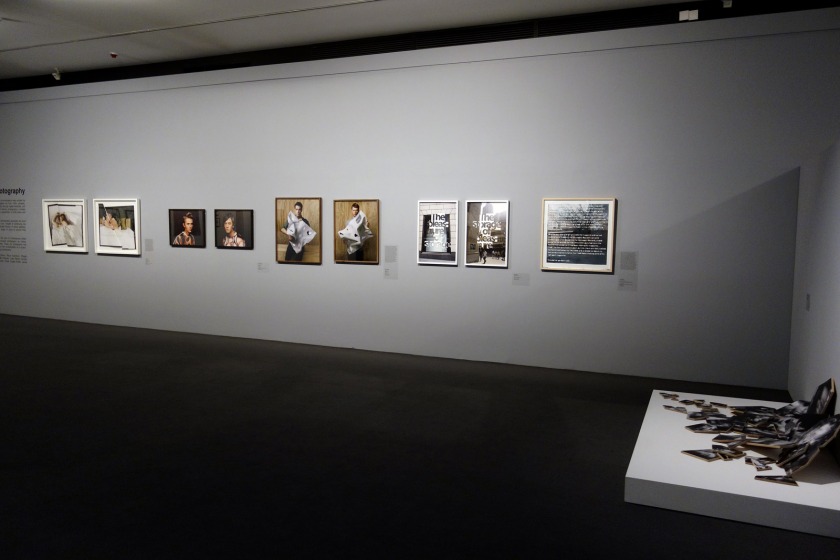


Installation photographs of the exhibition Cutting edge: 21st-century photography at the Monash Gallery of Art
Photos: © Marcus Bunyan and the Monash Gallery of Art
In the early years of the 21st century many cultural commentators were excited by the prospect of photography becoming a truly global art form. With cameras, computers and printers all communicating seamlessly through digital networks, and with the internet providing a worldwide platform for sharing photographs, it looked like the photographic medium might transcend the specificities of both place and materials.
While global digital networks have clearly impacted photography generally, the work of many art photographers has taken a different turn. Instead of embracing the seamless space of digital production, or the expanded horizon of online galleries, artists working with photography have found a range of ways to ground their practices in the material world.
Cutting edge: 21st-century photography features the work of contemporary artists who disrupt the seamless uniformity of screen-based photography by cutting, pinning, folding and puncturing photographic prints. These are photographs that need to be engaged with in physical space, rather than contemplated on a screen; this is an exhibition about making rather than taking photographs.”
Text from the Monash Gallery of Art

Installation photograph of Danica Chappell. Light shadow (5 days + 5 hrs in 8 parts + test strips) 2012-2015 (detail)
Photo: © Marcus Bunyan and the Monash Gallery of Art
Danica Chappell‘s practice belongs to a long artistic tradition of visual abstraction, which rejects representation in favour of sensual and experimental processes. While this tradition is dominated by painters, Chappell employs the light-sensitive chemistry of traditional photography to generate her images. Even though Chappell’s practice can be described as ‘photographic’, she doesn’t use a camera to produce her work. This helps turn photography into something abstract, rather than representational, but it also allows Chappell to distance herself from the ‘instamatic moment’ and foreground an extended process of creative intuition with colour and form. The work being exhibited here, Light shadow (5 days + 5 hrs in 8 parts + test strips), was created in a colour darkroom over several hours. Approaching this as a type of unseeable performance, Chappell arranged and rearranged scraps of paper and other off-cuts on the light sensitive paper while exposing it to light for different periods of time. Chappell’s final installation of this work incorporates test strips, which have been placed at intervals over the print. The test strips, which were integral in the making of the work, interrupt the fl ow of the underlying print, adding an extra layer of abstraction and temporality.


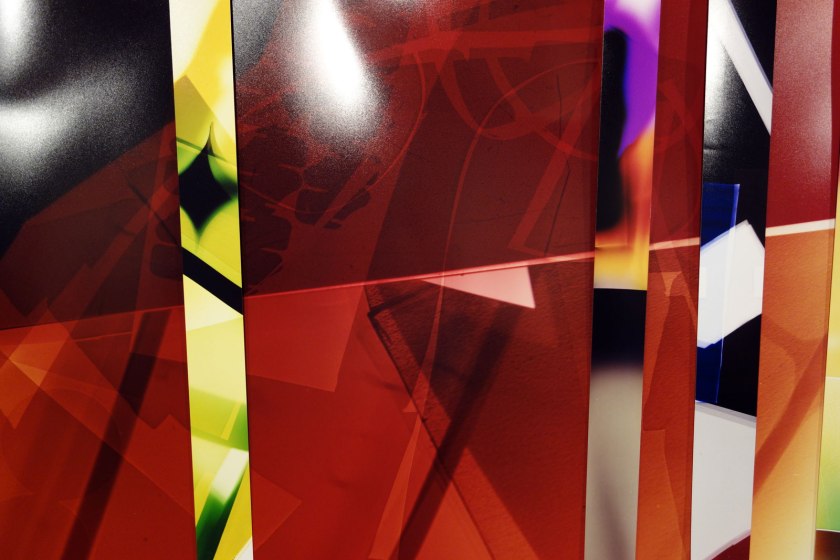

Danica Chappell (Australian, b. 1972)
Light shadow (5 days + 5 hrs in 8 parts + test strips) (details)
2012-2015
Chromogenic prints
Collection of the artist
Photos: © Marcus Bunyan and the Monash Gallery of Art

Installation view of David Rosetzky. Aaron I 2004 and Hamish 2004
Photo: © Marcus Bunyan and the Monash Gallery of Art

David Rosetzky (Australian, b. 1970)
Hamish
2004
Chromogenic prints
Courtesy of the artist and Sutton Gallery (Melbourne)
Monash Gallery of Art, City of Monash Collection acquired 2005
David Rosetzky‘s practice encompasses a range of media, including video and photography, and typically explores themes of identity and interpersonal relationships. Throughout his career, Rosetzky has created photographic series and has periodically returned to work on photographic cut-out and collaged portraits. To produce these images, Rosetzky creates cool studio portraits of young models, referencing the style of photography found in advertising and fashion magazines. He then layers as many as three photographic portraits on top of each other before hand cutting sections to reveal parts of the underlying prints (above). Through these works Rosetzky represents his subjects as being multi-layered and highlights the idea that identity is fragile, changeable and often concealed. The crumpled paper, represented in his more recent portraits (below), suggests that surfaces are dynamic thresholds rather than superficial masks. Used in a photographic context, the crumpled paper can also be seen as a reference to photography’s power to transform and elaborate a person’s social identity.

David Rosetzky (Australian, b. 1970)
Pieces #1 (installation view)
2015
Chromogenic prints
Collection of Ten Cubed
Collection of the artist
Photo: © Marcus Bunyan and the Monash Gallery of Art

David Rosetzky (Australian, b. 1970)
Pieces #2
2015
Chromogenic prints
Courtesy of the artist and Sutton Gallery (Melbourne)
Collection of Ten Cubed
Collection of the artist
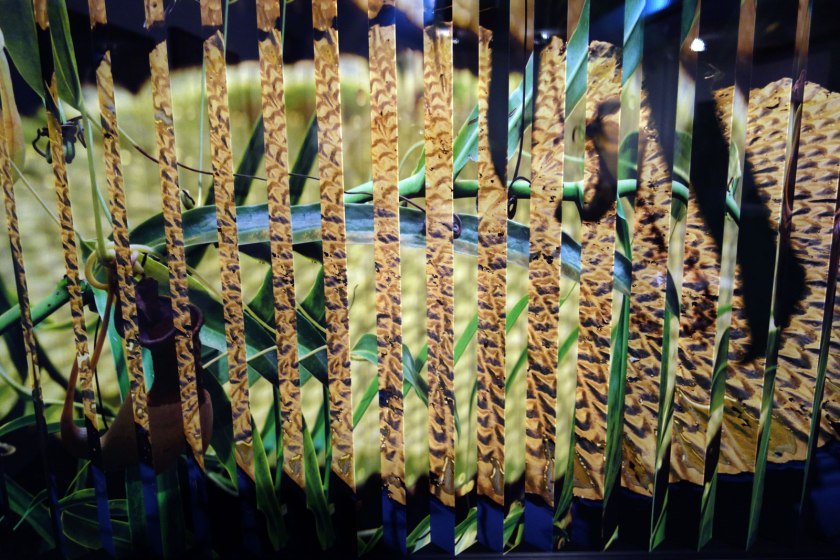
Megan Jenkinson (New Zealand, b. 1958)
meniscus (installation view detail)
2014
From the series Transfigurations
Pigment ink-jet print
Collection of the artist
Photo: © Marcus Bunyan and the Monash Gallery of Art
Megan Jenkinson began working with lenticular printing technologies in 2007. Lenticular printing combines multiple still images to give the impression of movement and three-dimensionality. The work on display here is from Jenkinson’s Transfigurations series, which employs a handmade form of lenticular photography to evoke the transience of the natural world. This large-scale image of water foliage is composed of two separate photographs that have been digitally spliced together and printed on a single sheet of paper. The artist has then hand-folded the photograph to create a concertinaed surface that can only be seen in its complete form when viewed from multiple angles. As a consequence, viewers need to physically interact with the photographic object, walking from side-to-side in order to experience the artwork. This form of photography disrupts traditional expectations of two-dimensional photography and introduces a tactile aspect to digital production.

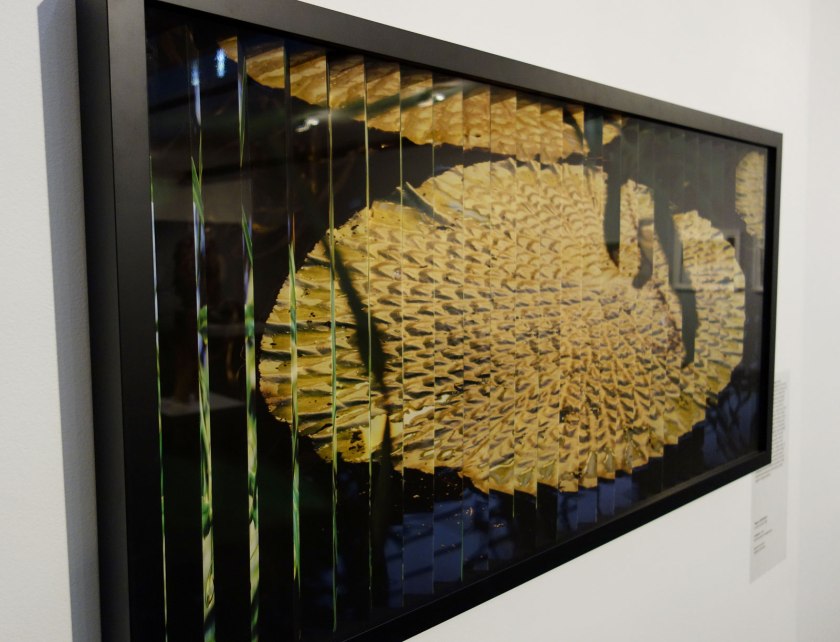
Megan Jenkinson (New Zealand, b. 1958)
meniscus (installation view details)
2014
From the series Transfigurations
Pigment ink-jet print
Collection of the artist
Photos: © Marcus Bunyan and the Monash Gallery of Art

Installation view of works by Justine Khamara
Looping #3 2014
Distended #2 2013
Ghosting’s ghost #2 2010
Orbital spin trick #2 2013
Photo: © Marcus Bunyan and the Monash Gallery of Art
In a world where photographs are often viewed on screens, Justine Khamara is interested in the physicality of the photographic surface and how this affects the meaning of an image. Her works begin as two-dimensional photographic portraits, which she then sculpts into three-dimensional forms that protrude from walls or stand alone in exhibition spaces. To create these works, Khamara cuts her photographic prints, either by hand or using a laser cutter. She then manipulates the intricately shredded surfaces by hand to give them a sculptural form. This involves an array of different techniques, such as adhering part of the photograph to a backing board and allowing the filleted paper to hang loosely from the top. In other instances she pulls and weaves the segmented photograph to create more purposeful geometric shapes. By working in this way, Khamara invests the photographic still with a sense of movement and playful elaboration, which effaces the mechanical nature of photographic reproduction.

Justine Khamara (born Australia 1971)
Orbital spin trick #2
2013
UV print on plywood
50.0 x 50.0 x 50.0cm
Reproduction courtesy of the artist and ARC ONE Gallery (Melbourne)
Collection of the artist



Justine Khamara (Australian, b. 1971)
Orbital spin trick #2 (installation view details)
2013
UV print on plywood
Collection of the artist
Photos: © Marcus Bunyan and the Monash Gallery of Art


Justine Khamara (Australian, b. 1971)
Looping #3 (installation view details)
2014
Chromogenic prints
Collection of the artist
Photos: © Marcus Bunyan and the Monash Gallery of Art

Luke Parker (Australian, b. 1975)
Screen memory (installation view)
2014
From the series Screen memory
Mixed media
Collection of Mikala Dwyer and David Corben
Collection of the artist
Photo: © Marcus Bunyan and the Monash Gallery of Art
Luke Parker works across a range of media, his practice is largely concerned with giving a sense of metaphysical weight to everyday events and chance encounters. The works on display here are made up of Parker’s own photographs combined with found images that he has collected over the past 20 years. To create these works, Parker categorised seemingly disparate images according to formal patterns and poetic associations. He then arranged the images onto a unifying background and used a needle and thread to stitch them into a type of artistic circuit board. Parker created this series as a way of making sense of his own image archive as well as the proliferation of images encountered in everyday life.
In a world where images are increasingly set adrift from specific economies of meaning, to circulate freely through digital networks, Parker’s works function as conceptual nets that encourage viewers to think about photographs rather than just watch them pass by.


Martin Smith (born Australia 1972)
After seeing every episode twice (installation views)
2006
Chromogenic print
Monash Gallery of Art, City of Monash Collection acquired 2008
Photos: © Marcus Bunyan and the Monash Gallery of Art
Martin Smith‘s practice revolves around the integration of photography and text. Using photographs that have been recovered from family albums or personal archives, Smith incorporates texts into the visual fi eld of the image. The texts, which have no obvious relationship with the content of the photographs, recall personal memories or lyrics from popular songs. To incorporate the texts, Smith hand-cuts letters out of the photographic prints, often leaving the letters scattered beneath the image. The disconnect between the text and the image is a deliberate attempt to combine two discrete methods of storytelling – image and text – while also emphasising the way memories of an event are usually different from the original experience. By cutting letters out of the photograph, Smith complicates the viewer’s ability to believe in either the text or the image, and opens up a space that encourages new interpretations.


Martin Smith (born Australia 1972)
pleasure / storage (installation views)
2012
Pigment ink-jet prints
Collection of the artist
Photos: © Marcus Bunyan and the Monash Gallery of Art

Installation view of Paul Knight. Untitled (PK_10_05) 2010 and Untitled (PK_10_02) 2010
Photo: © Marcus Bunyan and the Monash Gallery of Art
Paul Knight‘s style of his photographs is influenced by his background in commercial photography; they are technically proficient and almost illustrative in their documentary clarity. These cool formal qualities, however, are unsettled by the subject matter, which is often about private desires and passions. Knight’s 2010-11 untitled series of folded photographs document couples embracing in bed. The series reflects Knight’s broader interest in photographing moments of candour and intimacy between lovers, which remains a preoccupation of his practice. In this series, however, Knight has folded the photographic prints to frustrate any expectation we might have about a photograph’s capacity to show or reveal its subject. Instead of offering a crude, voyeuristic perspective, the intimacy documented in these images is obscured and concealed in the folds of the print.
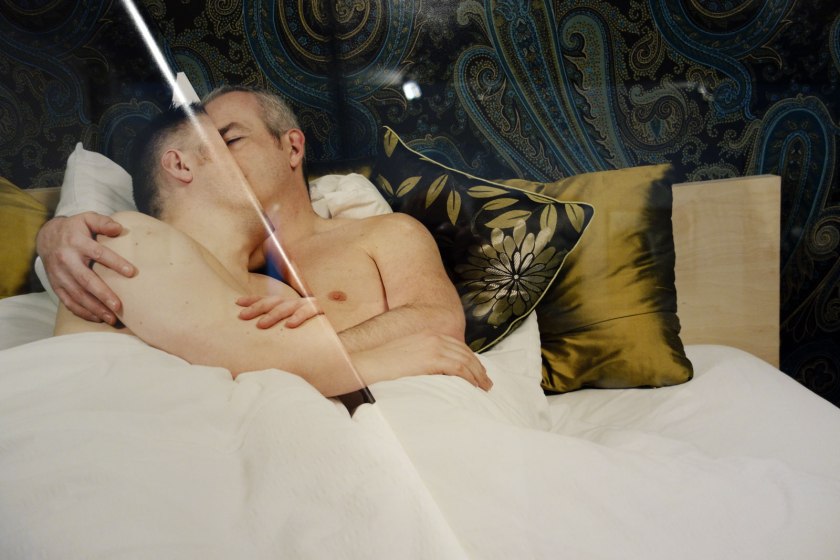
Paul Knight (born Australia 1976)
Untitled (PK_10_02) (installation view)
2010
Chromogenic prints
Monash Gallery of Art, City of Monash Collection acquired 2010
Photo: © Marcus Bunyan and the Monash Gallery of Art

Emidio Puglielli (born Australia 1964)
Colourful mountain disruption (installation view)
2009
Chromogenic print, pins
Collection of the artist
Photo: © Marcus Bunyan and the Monash Gallery of Art
Emidio Puglielli‘s work focuses on the relationship between the photograph as a material object and the photograph as an image. He is particularly interested in old photographs and their continued resonance in contemporary society. Puglielli finds and collects vernacular photography to use as the starting point for his works. He then highlights the materiality of the photographs by drawing attention to their surface and structure. To do this he employs strategies such as rubbing off the emulsion or piercing the surface with map pins. Puglielli is interested in the way such interventions alter the meaning of a photograph and offer new readings of images.
By damaging the smooth surface of the print, he is able to disrupt the illusion of the photographic image, but his interventions also embellish the photographs in sympathetic ways. This is particularly evident in Snow disruption, where the pins appear as snowflakes, and Shadow disruption where pins become eyeballs in the shadow of the unknown photographer. Puglielli’s works therefore seek to question the nature of photography and the way in which photographs are viewed and reinterpreted.

Installation view of Vivian Cooper Smith. Timeless 2013
Photo: © Marcus Bunyan and the Monash Gallery of Art
Vivian Cooper Smith‘s artistic practice revolves around photography. Timeless (2013) explores identity and conceptions of self while also reflecting on the nature of photography. To create this work, Smith photographed film noir classics directly from an old television screen. He then printed the images and hand-cut them to fit pieces of irregularly shaped plywood. Smith created this work during a period of personal turmoil and felt that the film noir genre of the post-war period resonated with his own desire to remake himself after a relationship breakdown. As is common to his practice, Smith has interfered with the photograph’s smooth, seamless surface, in this case by dissecting it and creating a three dimensional sculpture. By focussing on the materiality of the photograph, Smith aims to highlight its artificial or constructed nature.


Vivian Cooper Smith (born New Zealand 1974; arrived Australia 1987)
Timeless (installation view details)
2013
Chromogenic prints
Collection of the artist
Photos: © Marcus Bunyan and the Monash Gallery of Art
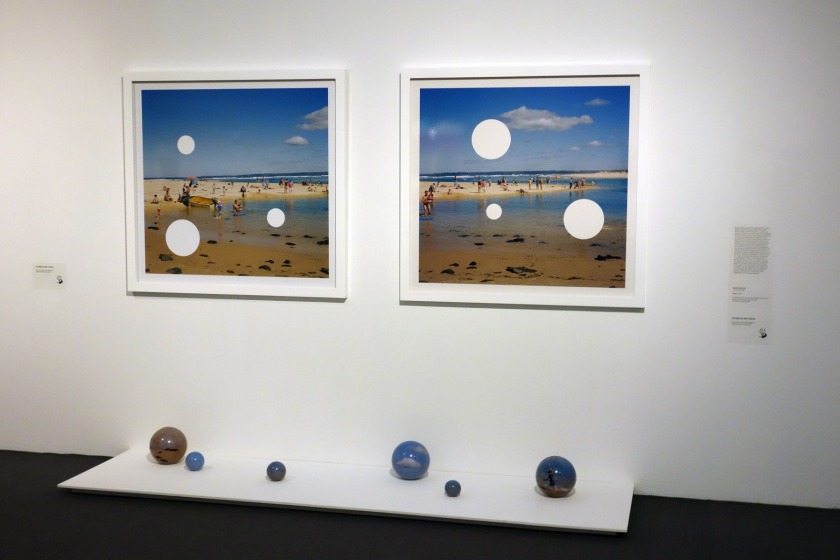
Installation view of Derek Kreckler. Holey 1 2003
Photo: © Marcus Bunyan and the Monash Gallery of Art
Derek Kreckler originally trained as a sculptor and established himself as a performance and sound artist during the 1990s, he has more recently concentrated on producing photographic and installation work. Kreckler’s Holey series consists of beach scenes and seascapes that have been punctured with circular apertures. The excised sections of the images have been transformed into spherical objects that sit in front of the two photographs, as if the photographs have spawned offspring from their holey orifices. This sculptural configuration challenges the notion that photography offers a straightforward document of time and place. Instead, the photograph has been turned into a type of puzzle that the viewer is encouraged to investigate and solve. To further deepen the viewing experience, Holey 1 is a diptych. The two photographs show the same location; the right side captured a short time after the left side. A number of the subjects in the photographs, beach goers on a summer’s day, are displaced by time. Some have remained static, some seem to have meandered between beach and sand, whilst others have disappeared from the scene altogether.


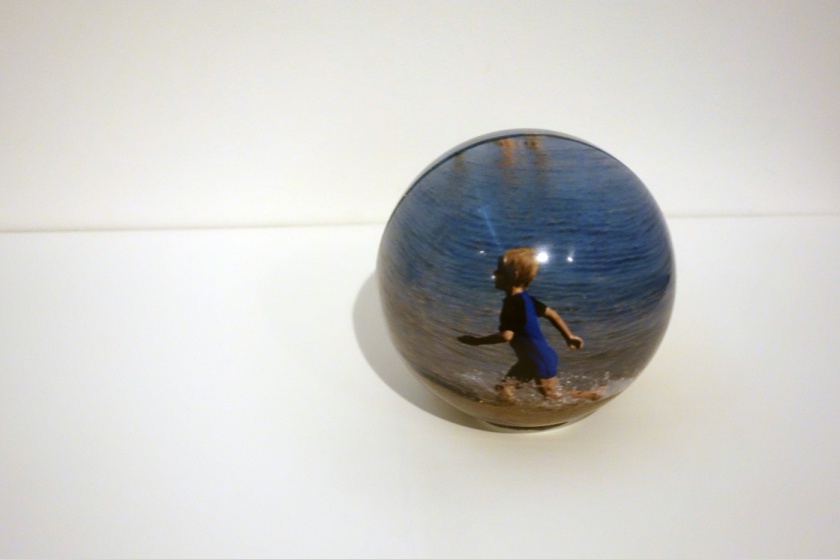
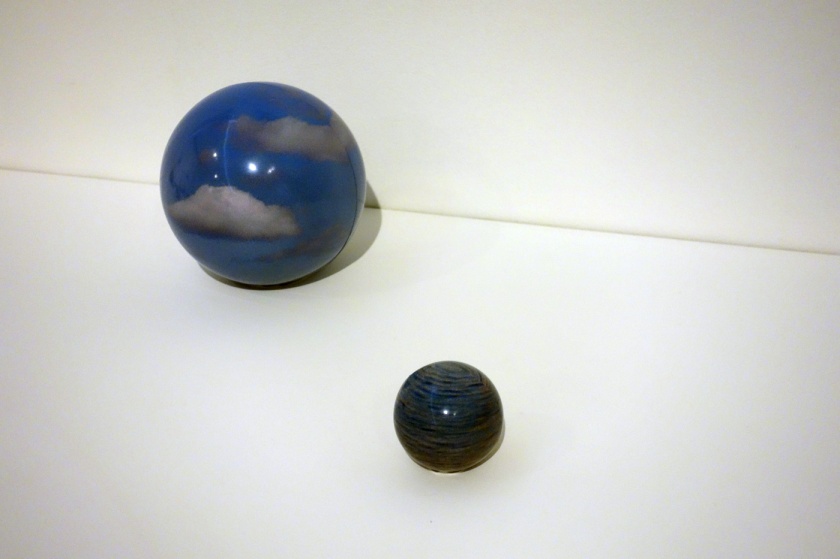
Derek Kreckler (Australian, b. 1952)
Holey 1 (installation view details)
2003
Chromogenic prints, spun aluminium spheres and cast vinyl
South Australian Government Grant 2004
Art Gallery of South Australia
Photos: © Marcus Bunyan and the Monash Gallery of Art
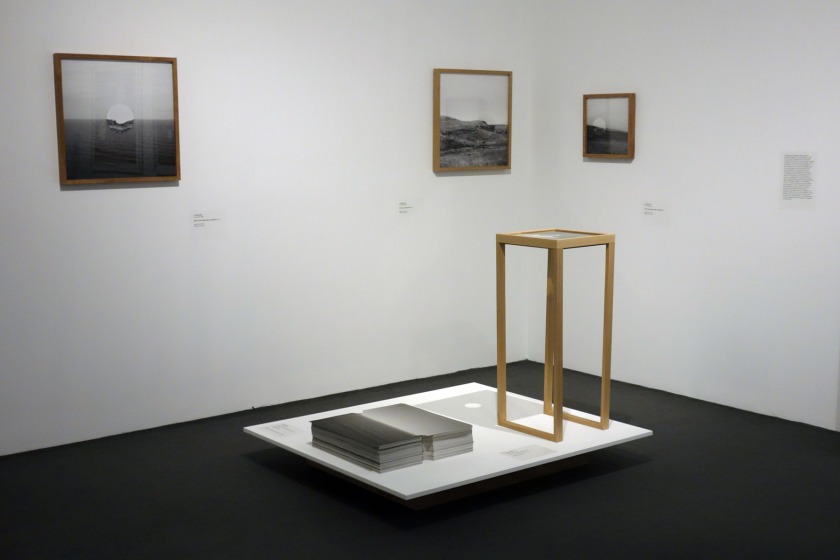
Installation view of the work of Jo Scicluna in the exhibition Cutting edge: 21st-century photography
Photo: © Marcus Bunyan and the Monash Gallery of Art
Jo Scicluna works with a range of media, including photography, video, sculpture and installation, often combining these art forms to bring photography into the space of lived experience. Dissatisfied with the way photography, as a documentary device, is almost always tied to past events, Scicluna encourages viewers to engage with the presence of photographic objects. By cutting into the smooth surface of a photographic print, she disrupts the notion that a photograph is a window into the past. She also elaborates conceptual relationships between different photographic objects in her installations. In doing this, Scicluna activates the space between the photographic print, the sculptural form and the phenomenology of a gallery space. For Scicluna, the experience of being in-between things is related to her personal experience of migration and geographic rupture. Scicluna is not interested in using photography to create documents of specific times and places but uses the medium in a conceptual way to evoke sensations that are not as easy to represent in a literal sense.

Jo Scicluna (born Australia 1969)
Where I have always been an island #4 (installation view)
2014
Pigment ink-jet prints
Collection of the artist
Photo: © Marcus Bunyan and the Monash Gallery of Art

Jo Scicluna (born Australia 1969)
When our horizons meet
2013
Pigment ink-jet prints
60 x 60cm
Collection of the artist


Jo Scicluna (born Australia 1969)
Where we begin (sunless) (installation view details)
2014
Pigment ink-jet print, acrylic, timber
Collection of the artist
Photos: © Marcus Bunyan and the Monash Gallery of Art

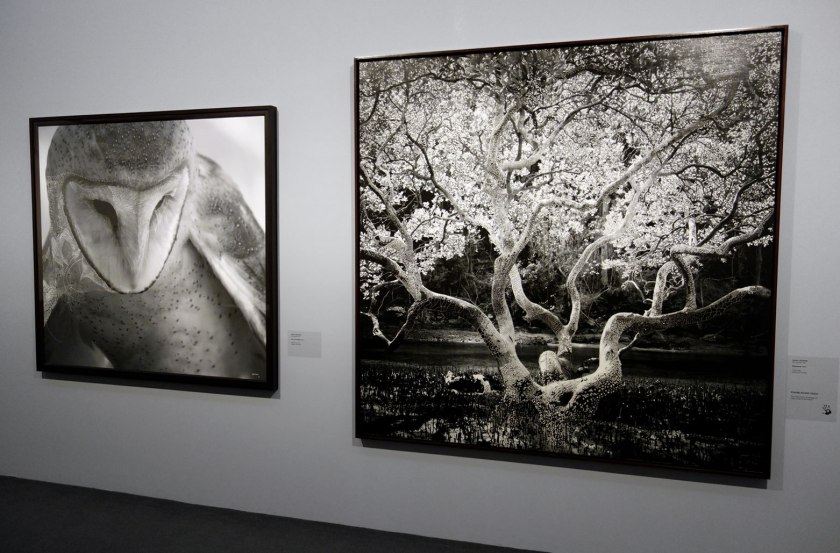
Installation views of the work of Joshua Yeldham in the exhibition Cutting edge: 21st-century photography
Photos: © Marcus Bunyan and the Monash Gallery of Art
Joshua Yeldham uses a range of media, his practice is focused on exploring the landscape and elaborating spiritual and symbolic narratives around his engagement with the natural world. He captures photographic images on a smart phone before blowing them up and printing them on cotton paper. He then uses tools to physically carve into the paper, disrupting the smooth surface of the photographic image and adding a personal, handmade effect. It is as if the artist is tattooing his own map or story into the skin of the image. The intricate carving creates a textured pattern of lightness over his otherwise dark and mysterious photographs. The technique allows Yeldham to explore history and mythology in the landscape and imbue his works with elements of both the real and the imagined. It also allows him to reference the passing of time as well as the weather and destruction that the natural environment endures on a daily basis.

Joshua Yeldham (born Australia 1970)
Owl of tranquillity (installation view detail)
2015
Pigment ink-jet print
Collection of the artist
Photo: © Marcus Bunyan and the Monash Gallery of Art


Joshua Yeldham (born Australia 1970)
Resonance (installation view details)
2015
Mixed media
Collection of the artist
Photos: © Marcus Bunyan and the Monash Gallery of Art
Monash Gallery of Art
860 Ferntree Gully Road, Wheelers Hill
Victoria 3150 Australia
Phone: + 61 3 8544 0500
Opening hours:
Tue – Fri: 10am – 5pm
Sat – Sun: 10pm – 4pm
Mon/public holidays: closed
Monash Gallery of Art website
LIKE ART BLART ON FACEBOOK
Back to top








































































You must be logged in to post a comment.